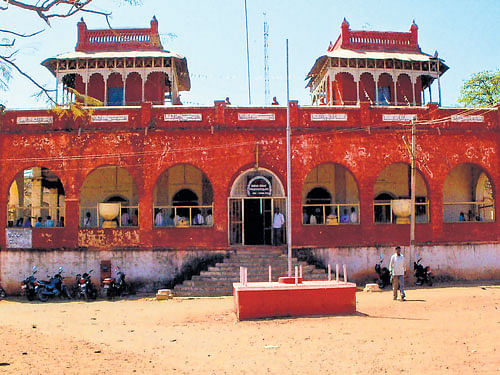
Rahman Azer draws our attention to the quaint town of Savanur, its etymology, history and speciality, by citing interesting anecdotes from days gone by.
Just as pedas are synonymous with Dharwad, Savanur is well known for its paan (betel leaves) and khara (mixture). Situated 45 km from Hubli, Savanur was once a princely state. Although it is home to several natural and manmade attractions, little has been done to tap its tourism potential.
The Nawabs of Savanur belonged to the Meyanna tribe of Afghanistan, who were good fighters. They ruled North Karnataka, which comprised parts of Dharwad, Bijapur, Belgaum and Haveri districts. Abdul Karim Khan was a chieftain of Bankapur under Sikandar Adil Shah.
His successor Nawab Abdul Rauf Khan was married to one of Aurangzeb’s daughter. He received Torgal and Azamnagar (Belgaum) from Aurangzeb in the form of jagirs. He was made in charge of a territory, which was then under the Adil Shahis and ruled from Bankapur. This tiny state was surrounded by regions ruled by the Marathas, Nizams, Haidar Ali and Tipu Sultan.
A tale of bravery
There goes an interesting legend as to how the Nawab founded his new capital, Savanur. The Nawab, like most rulers of the medieval period, was fond of hunting.
Once, when he was on such an expedition, he reached a village called Janmaranhalli, where he sighted a hare. He ordered his dog to chase it. To his surprise, the hare remained undaunted and charged towards the dog. This unusual scene influenced the Nawab greatly and he decided to make that particular place his new capital.
He called it Shahnoor (king of light in Persian and Urdu). Over a period of time, the name transformed to Savanur. Another version goes that since the capital was shifted in the month of Shravan, it was called Savanur.
The Nawab was tolerant of all religions and had a broad outlook. He generously donated huge sums of money and granted jagirs for the maintenance of mutts and temples. The Nawab also promoted trade with other states. Cotton, jowar and betel leaves of Savanur were exported to other states under his rule.
Before independence, although small, Savanur was considered a model state. It had a printing press, schools, hospitals, good roads, tanks and wells for drinking water and irrigation purposes. The Nawabs also encouraged paan cultivation in their state. Nawab Abdul Majid Khan was responsible for a settlement of traders at Hubli, which was known as Majidpur.
The Savanur Nawabs had allied with the Marathas. Haidar Ali had attacked Savanur in 1763 and the Nawab was defeated. Haidar Ali was a great military strategist. In order to make his northern borders secure, he tried to have good relations with the Nawabs of Savanur, Kadapa and Karnul.
He had even planned a “double marriage tie” with Savanur’s Nawab Abdul Hakim Khan. He gave his daughter Sultana Begum in marriage to the Nawab’s son Khair Khan. Haidar Ali’s younger son Karim Shah married the Nawab’s daughter, Nawaz Begum.
Tipu Sultan succeeded the throne after Haidar Ali’s death in 1782. He had invited Nawab Abdul Hakim Khan for his enthronement at Srirangapatna. The Nawab ignored it this friendly gesture of Tipu which made Tipu Sultan attack Savanur in 1786. The Nawab was defeated and he fled from Savanur to join the Marathas leaving everything at his palace.
After the death of Nawab Tabreiz Khan, an infant Abdul Majid Khan II succeeded. As his guardian, his grandfather Dad Muhammed Khan ruled the state. He was educated and trained by the British and at the age of 22, he was made the Nawab.
The state prospered under him.In fact, the credit of transforming Savanur, from a medieval state to a flourishing modern state goes to him. The Nawab stayed at his new palace called Majid Castle, which is now the Taluk Panchayat Office.
Heritage
There is a five-gated fort at Savanur, which is now in ruins. Before moving to its own building, the court functioned from the Nawab’s beautiful red rectangular palace. During the British period, visitors were highly impressed by its gardens, fountains and surroundings.
Today, only the building remains. The state government is converting it into a museum. A very large iron bowl and two small guns adorn this monument which represents impressive Islamic architecture with sacred Arabic inscriptions in the region.
A mutt of Dvaita philosophy propagator, saint Sri Satyabodhatirtha is an important pilgrim centre here.The saint is said to have had cordial relations with the Nawab, Tipu Sultan and other Muslim rulers. There are also dargahs of Hazrat Kamal Pasha, Mohammed Rafaee Pasha and Hamdu Waris Miyan.
One of the dargahs has ball-shaped stones of different sizes. People believe that if a stone is placed on one’s body it will relieve one of all the pain. It is said that Sayyeda Bibi Maa Sahiba had come here from Surat. The devotees believe that her grave rotated in the past.
There are three rare bottle-shaped Baobab trees, situated in the vicinity of Doddahunse Mutt. It is said that cooked food kept under them does not get contaminated and remains fresh. According to Sri Channabasava Swami of Doddahunse Mutt, Saint Goraknath had planted them. Their leaves and fruits have medicinal properties and are worshipped by devotees.
Matter of pride
Well-known litterateur V K Gokak was born in Savanur. A Jnanpith awardee, he was a renowned Kannada poet and educationist. He had headed a committee set up by the state government for giving primacy to Kannada. To commemorate his services, a Dr V K Gokak Smarak Bhavan is coming up near the old court.
A M Havaldar, a retired municipal commissioner in the town observes: “The local administration has ignored this historic town, where paan cultivation is spread over 800 acres of land. A special variety of betel leaves called kaala paan remains fresh for a month. It is in great demand not only in neighbouring states, but as far as Karachi.”